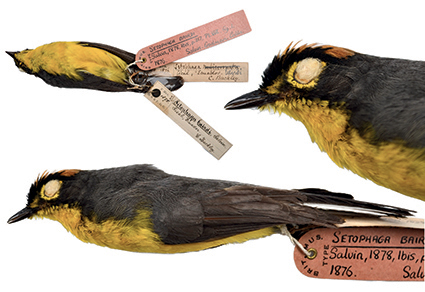Hightower, J. N., Crawford, D. L., Thogmartin, W. E., Aldinger, K. R., Swarthout, S. B., Buehler, D. A., Confer, J., Friis, C., Larkin, J. L., Lowe, J. D., Piorkowski, M., Rohrbaugh, R. W., Rosenberg, K. V., Smalling, C., Wood, P. B., Vallender, R., and Roth, A. M. (2022).
Change in climatically suitable breeding distributions reduces hybridization potential between Vermivora warblers. Diversity and Distributions, first published 23 December 2022.
https://doi.org/10.1111/ddi.13659
Abstract
Aim
Climate change is affecting the distribution of species and subsequent biotic interactions, including hybridization potential. The imperiled Golden-winged Warbler (GWWA) [
Vermivora chrysoptera] competes and hybridizes with the Blue-winged Warbler (BWWA) [
Vermivora cyanoptera], which may threaten the persistence of GWWA due to introgression. We examined how climate change is likely to alter the breeding distributions and potential for hybridization between GWWA and BWWA.
Location
North America.
Methods
We used GWWA and BWWA occurrence data to model climatically suitable conditions under historical and future climate scenarios. Models were parameterized with 13 bioclimatic variables and 3 topographic variables. Using ensemble modeling, we estimated historical and modern distributions, as well as a projected distribution under six future climate scenarios. We quantified breeding distribution area, the position of and amount of overlap between GWWA and BWWA distributions under each climate scenario. We summarized the top explanatory variables in our model to predict environmental parameters of the distributions under future climate scenarios relative to historical climate.
Results
GWWA and BWWA distributions are projected to substantially change under future climate scenarios. GWWA are projected to undergo the greatest change; the area of climatically suitable breeding season conditions is expected to shift north to northwest; and range contraction is predicted in five out of six future climate scenarios. Climatically suitable conditions for BWWA decreased in four of the six future climate scenarios, while the distribution is projected to shift east. A reduction in overlapping distributions for GWWA and BWWA is projected under all six future climate scenarios.
Main Conclusions
Climate change is expected to substantially alter the area of climatically suitable conditions for GWWA and BWWA, with the southern portion of the current breeding ranges likely to become climatically unsuitable. However, interactions between BWWA and GWWA are expected to decline with the decrease in overlapping habitat, which may reduce the risk of genetic introgression.


 academic.oup.com
academic.oup.com









